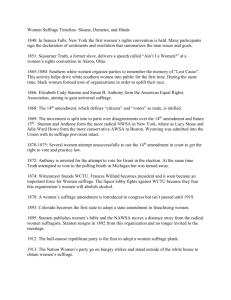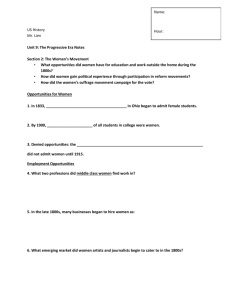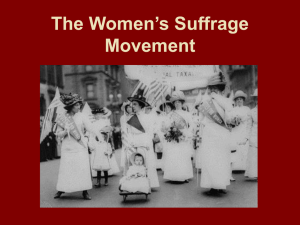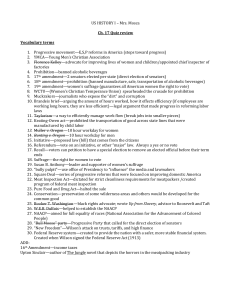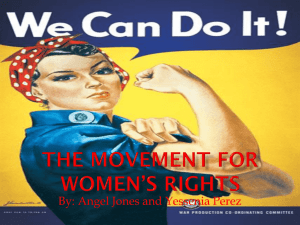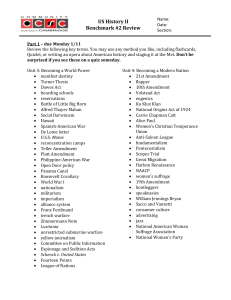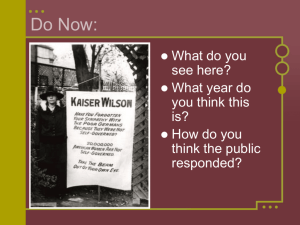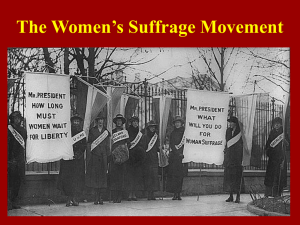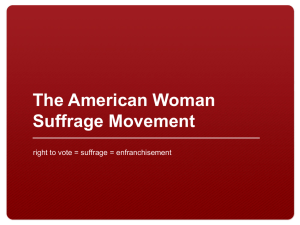Power Point
advertisement
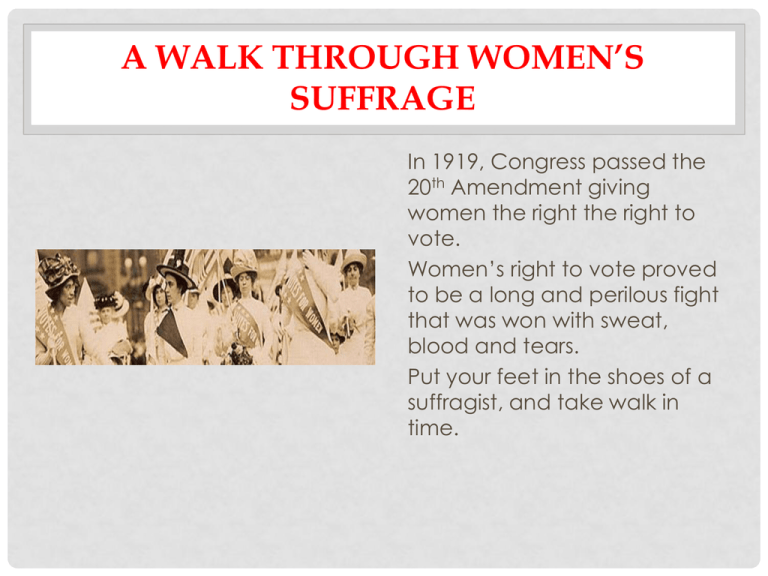
A WALK THROUGH WOMEN’S SUFFRAGE In 1919, Congress passed the 20th Amendment giving women the right the right to vote. Women’s right to vote proved to be a long and perilous fight that was won with sweat, blood and tears. Put your feet in the shoes of a suffragist, and take walk in time. A WALK THROUGH TIME: TIMELINE OF WOMEN’S SUFFRAGE BY CATHERINE PORLIER THE BEGINNING 1776 Abigail Adams writes to her husband, John, who is attending the Continental Congress in Philadelphia, asking that he and the other men--who were at work on the Declaration of Independence--"Remember the Ladies." John responds with humor. The Declaration's wording specifies that "all men are created equal." UNEQUAL RIGHTS NO GIRLS ALLOWED Women had it difficult in the mid-1800s to early 1900s. There was a difference in the treatment of men and women. For example: Married women were legally limited in the eyes of the law Women were not allowed to vote Women had to submit to laws when they had no voice in their formation Married women had little rights to own property (unless inherited) Women had very little means to gain an education since no college or university would accept women students. Women were not allowed to enter professions such as medicine or law (with only a few exceptions) Women were not allowed to participate in the affairs of the church Women were dependent mostly on their husbands for income Women's Rights 1848-1920." 123HelpMe.com. 05 Mar 2011 The Fight for Change Begins Then the first Women's Rights Convention was held on July 19 and 20 in 1848. The convention was convened as planned, and over the two-days of discussion, the Declaration of Sentiments and 12 resolutions received agreement endorsement, one by one, with a few amendments SOJOURNER TRUTH (1797-1883) In 1843, Isabella, a former slave, changed her name to Sojourner Truth and began traveling through the eastern United States preaching the word of God. In Northampton, Massachusetts, she encountered the abolitionist movement and began traveling and lecturing on behalf of that cause. She maintained herself by selling copies of the Narrative of Sojourner Truth, which had been written by Olive Gilbert and published in 1850. After attending a women's rights convention in 1850, Truth also became a speaker on women's rights issues. During the Civil War she solicited gifts of food for regiments of black volunteers, and after the war she worked to find homes and employment for recently freed slaves. Adapted from biographies prepared by Mary M. Huth, Department of Rare Books and Special Collections, University of Rochester Libraries, February 1995 SUSAN B. ANTHONY (1820-1906) For over 50 years, Susan B. Anthony was the leader of the American woman suffrage movement. Born in Adams, Massachusetts on February 15, 1820, Anthony lived for many years in Rochester. In 1872 Anthony was arrested for voting. When she died in 1906, only four states allowed women to vote, but Anthony's single-minded dedication to the cause of suffrage was largely responsible for the passage of the nineteenth amendment to the United States Constitution in 1920, giving women the vote. Adapted from biographies prepared by Mary M. Huth, Department of Rare Books and Special Collections, University of Rochester Libraries, February 1995 Lucy Stone (1818-1893) along with Susan B. Anthony and Lucretia Mott, helped coordinate the first national American women's rights convention, held in Worcester, Massachusetts. For many years, Stone earned a living as an antislavery and women's rights lecturer, and from 1872 until her death in 1893, she co-edited with her husband, Henry Brown Blackwell, the premier women's suffrage newspaper, the Woman's Journal. Library of Congress Manuscript Division Washington, D.C. 20540 USA A Resolution Proposing an Amendment to The Constitution Of The United States In July 1848 Elizabeth Cady Stanton and Lucretia Mott organized the first women's rights convention in Seneca Falls, NY, and launched the woman suffrage movement. Many of the attendees to the convention were also abolitionists whose goals included universal suffrage. In 1870 this goal was partially realized when the 15th amendment to the Constitution, granting black men the right to vote, was ratified. "This call was published in the Seneca County courier, July 14, 1848, without any signatures. The movers of this convention, who drafted the call, the declaration and resolutions were Elizabeth Cady Stanton, Lucretia Mott, Martha C. Wright, Mary Ann McClintock, and Jane C. Hunt"--Footnote. Election Day! Political cartoon. c1909. From the Library of Congress, By Popular Demand: “Votes for Women” Suffrage Pictures, 1850-1920. Suffragist parade (1915) SMALL VICTORIES 1869 National Woman Suffrage Association is founded with Elizabeth Cady Stanton as president. American Woman Suffrage Association is founded with Henry Ward Beecher as president. Wyoming Territory grants suffrage to women. 1870 Utah Territory grants suffrage to women. MEN ONLY 15th Amendment A Step in the Right Direction?? The 15th amendment to the U. S. Constitution is adopted. The amendment grants suffrage to former male African-American slaves, but not to women. Anthony and Stanton bitterly oppose the amendment, which for the first time explicitly restricts voting rights to "males." Many of their former allies in the abolitionist movement, including Lucy Stone, support the amendment. Voting Rights for Women Dream to Reality Some battles for woman suffrage were won stateby-state by the early 20th century. Alice Paul and the National Women's Party (NWP) began using more radical tactics to work for a federal suffrage amendment to the Constitution: picketing the White House, staging large suffrage marches and demonstrations, going to jail. Thousands of ordinary women took part in these -- a family legend is that my grandmother was one of a number of women who chained themselves to a courthouse door in Minneapolis during this period. http://womenshistory.about.com/od/suffrage1900/a/august_26_wed.htm WOMEN VOTING On June 4, 1919, the United States Senate also endorsed the Amendment, voting 56 to 25, and sending the amendment to the states. Illinois, Wisconsin and Michigan were the first states to pass the law; Georgia and Alabama rushed to pass rejections. The anti-suffrage forces, which included both men and women, were well-organized, and passage of the amendment was not easy. “DON’T FORGET TO BE A GOOD BOY”: HARRY T. BURN’S MOM CHANGE’S HISTORY One young legislator, 24 year old Harry Burn, had voted with the antisuffrage forces to that time. But his mother had urged that he vote for the amendment and for suffrage. When he saw that the vote was very close, and with his anti-suffrage vote would be tied 48 to 48, he decided to vote as his mother had urged him: for the right of women to vote. And so on August 18, 1920, Tennessee became the 36th and deciding state to ratify. http://www.teachamericanhistory.org/File/Harry_T._Burn .pdf THE DREAM IS REALIZED National Woman’s Party activists watch Alice Paul sew a star onto the NWP Ratification Flag, representing another state’s ratification of the 19th Amendment. Photograph, ca.1919. From Library of Congress, Prints and Photographs Online Catalog. THE ROAD COMES TO AN END THE DREAM IS A REALITY On August 26, 1920, the Nineteenth Amendment to the United States Constitution became law, and women could vote in the fall elections, including in the Presidential election. From Library of Congress, Prints and Photographs Online Catalog.
